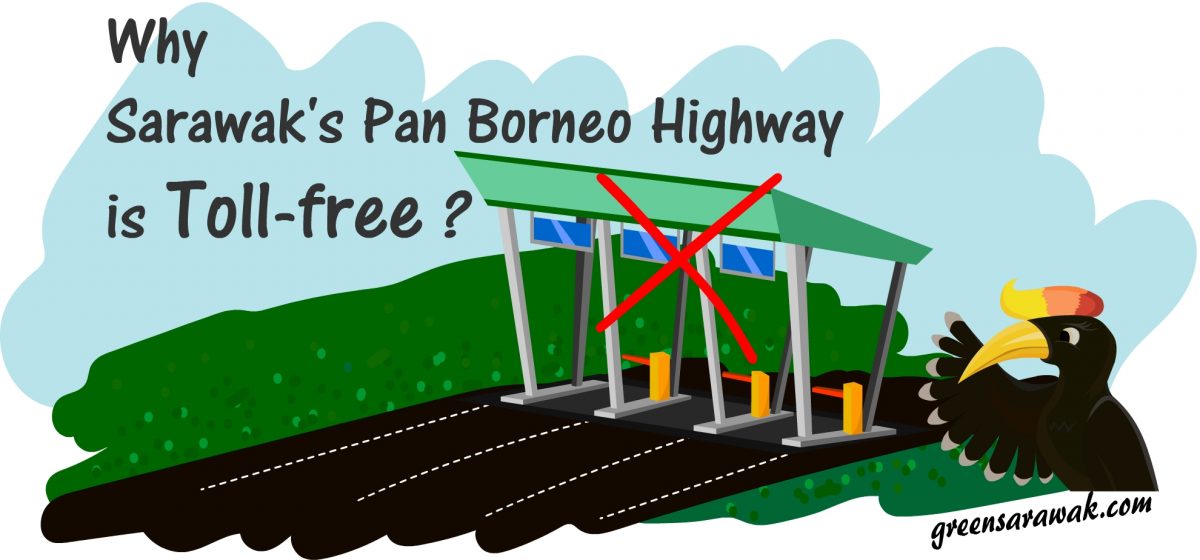It was a great relief that the state government state that the Sarawak’s section of Pan Borneo Highway will be toll-free. However skeptics still concerning about the toll issues in future roads. Lets find out what is toll roads about, and its implementation and limitations.
Tolls in general
Tolls means fees paying. A toll road will have a toll plaza or a toll booth located across a road. It is also known as Premium Roads. There are also toll bridges and toll tunnel.
Toll roads, bridge and tunnel exist for various reasons:
- To collect funds to cover up the incurred construction cost and maintenance cost of the road. All these “premium” infrastructure are almost always branded as premiums as involving higher quality build materials for increase speed limits and longevity of the structure. These translated to a higher cost of building and maintenance than normal infrastructure. The maintenance is usually very tight. Failure of maintenance will cost serious consequences like collapsed bridge and tunnels, accidents and dangerous pot holes on highway.
- To collect revenue for the state. It is obvious that the state will gain some form of revenue from the tolls. These revenue will be used for upgrading other facilities and value added services.
- To control traffic and usage. Toll infrastructure always exist along with non-toll infrastructure. When come to the concept of premiums, it will be accompany with a fee. User can use a faster connection using premium facilities but with a fee, or use free facilities with a longer commute and far indirect connections. Some country place toll in order to reduce individual vehicles on roads as to reduce the city traffic volume (and air pollution) and encourage the use of pooled vehicles and public transport.
Tolls can be collected either via cash counters or Digital prepaid cards. Digital or smart cards are preferred as it will shorten the queue for transaction.
Maintenance of toll plaza and toll booths was also not free. It involves man power and maintenance of building structures, automation devices and computer systems. The maintenance of toll plazas and booth occasionally cost a significant lost to the revenue gain from tolls.
Many are skeptical about existence of toll roads as some are considered regressive taxation and have burden to the lower income population rather than higher income populations.
Malaysian Expressway System
The Malaysian Expressway System forms the backbone networks of nation controlled roads and highways in Malaysia.
They were 30 expressways in the country and the total length is 1,821 kilometers. The well known expressway are the North–South Expressway which passes through all the major cities (Penang, Ipoh, the Klang Valley and Johor Bahru) in Peninsular Malaysia.
The major reason behind building the Expressway in Malaysia is because of increasing traffic volume in the existing Federal Route. These increase in traffic volume is due increase of population in major cities and towns, increase connectivity with bigger ports and airports, and increasing affordability of private transport vehicles. The building of Expressways accelerate the development of surrounding areas and reduce the connection time between cities.
Toll Expressway in Malaysia
All Malaysian toll expressways are controlled-access highway and managed in the Build-Operate-Transfer (BOT) system.
Controlled-access highway are also known as freeway or motorway, with the main purpose of unhindered flow of traffic (road vehicles), which it have no traffic signals, intersections, pedestrian paths, railways or property access directly to the Expressway. The only entrance and exit from the expressway is via specific interchanges to the collector roads. There are also feature of pedestrian footbridge, underpass or overpass for other roads and railroads, which do not directly connected with the highway.
Build–operate–transfer (BOT) usually applicable to various infrastructure projects including roads, railways and mass transit. It is a model that allows public-private partnership. To relieve the burden on the public finance alone (government), these infrastructure is usually designed, financed, build by private sector via a agreement or contract. After the construction of the infrastructure, the private sector have the ownership and rights to collect back revenue to recover the initial cost of building and maintenance for a certain period of time as per contract. However the infrastructure will be transferred back to the public administration once the contract expired.
Toll expressways in Malaysia are classify into Open tolls, close tolls and mixed (Open and Closed) tolls.
Open tolls will incur a fix payment to the user on the particular section of the expressway. While Closed Tolls require a ticket or PLUStransit cards during the entrance of the expressway and payment according to how much had been traveled at the exit of the expressway. When it involves a whole stretch of road like the north-south Expressway, it will become a mix variety.
The Open Tolls in Malaysia:
- Federal Highway (2)
- Second Link Expressway (E3)
- Shah Alam Expressway (E5)
- Cheras-Kajang Highway (E7)
- Kuala Lumpur-Karak Expressway (E8)
- Sungai Besi Expressway (E9)
- New Pantai Expressway (E10)
- Damansara-Puchong Expressway (E11)
- Ampang-Kuala Lumpur Elevated Highway (E12)
- Butterworth-Kulim Expressway (E15)
- Butterworth Outer Ring Road (E17)
- Kajang Dispersal Link Expressway (E18)
- Maju Expressway (E20)
- Western KL Traffic Dispersal System (E23)
- Tun Salahuddin Bridge (E24)
- Kuala Lumpur-Kuala Selangor Expressway (E25)
- Seramban-Port Dickson Highway (E29)
- New North Klang Straits Bypass (E30)
- Duta-Ulu Klang Expressway (E33)
- Guthrie Corridor Expressway (E35)
- Penang Bridge (E36)
- Stormwater Management and Road Tunnel (E38)
The Closed Tolls in Malaysia :
- New Klang Valley Expressway (E1)
- North-South Expressway, Central Link (E6)
- East Coast Expressway (E8)
- Senai-Desaru Expressway (E22)
- South Klang Valley Expressway (E26)
The Mixed Tolls in Malaysia:
- North-South Expressway, Northern Route (E1)
- North-South Expressway, Southern Route (E2)
- Kajang-Seremban Highway (E21)
- Penang Second Bridge (E28)
The Toll scenarios of Sarawak
We know that Peninsular Malaysia have many toll expressways. What about the Toll scenarios in Sarawak ?
The Tun Salahuddin Bridge in Kuching is the first only toll expressway in East Malaysia. The 6-lane, dual-deck Tun Salahudin Bridge is an elegant, 339 meters long, 28 meters wide low-level bridge over the Sarawak River. The bridge is completed on September 2003 and toll concession started on October 2003. However it was declared toll free after the ending of the 12 years toll concession in 1st January 2016.
The Sibu’s Lanang Bridge is a 1220 meter bridge constructed in 2003 across the Batang Rajang river. It comprises dual carriageway, four balanced cantilever spans and eight equal spans of 40 meters length at each side of the cantilever spans. It replace the former river ferry service that allow connection between Sibu and Sarikei (part of the Pan Borneo Highway at the Sarikei-Sibu section). The bridge is opened to public on 11 April 2006. Lanang Bridge is the lifeline of the people of Rajang River Basin, the initial toll had cause many criticism and burden to the locals. Although it meant to be a toll bridge for 22 years, however following a discussion between Chief Minister Datuk Patinggi Tan Sri Adenan Satem, Wong and Shin Yang Group of Companies chief executive officer Tan Sri Datuk Ling Chiong Hoe (the builder of the RM180 million bridge), Lanang Bridge becomes a toll free bridge staring 24 May 2015.
The Batang Baram Bridge or ASEAN Bridge is a 1040 meters bridge with 19 spans, crossing the Batang Baram river. It is located approximately 35km north of Miri City, 2km upstream of the New Miri Port Complex. It allows direct road access between Sarawak and Brunei with one of the end connecting the immigration Checkpoint at Sungai Tujuh. The Asean Bridge replacing the previously ferry service across Batang Baram. The Bridge completed in August 2003. The Asean Bridge was rated the most expensive toll bridge in Sarawak for the short distance traveled, quoting RM10 per use for a normal car. It creates much burden to the frequent travelers and daily commute between Miri and Brunei. Beginning 1st June 2015, the toll collection at the Asean Bridge in Miri was abolished.
The toll-free Sarawak policy was announced by Chief Minister Tan Sri Adenan Satem in April 2015.
Datuk Seri Najib Tun Razak, when launching the upgrading of construction works of the Pan Borneo Highway near Bintulu in April 2015, promised that the highway throughout Sarawak would be toll-free. The reasons being as this was the only highway linking the cities and towns of this vast state.
During the December Sarawak Legislative Assembly sitting in 2015, Adenan also reiterated that the state’s portion of the Pan Borneo Highway would be toll-free.
The prerequisite for implementing Tolls
There is few prerequisite for a toll roads or bridge.
- Toll infrastructure is also view as a “premium access” infrastructure. It will be a value added infrastructure that is different from preexisting infrastructure. These infrastructure is usually with higher quality, complexity and better maintenance service.
- Toll infrastructure usually co-exist with non-toll infrastructure for a competitive advantage. For example to connect a same destination, people can choose between a choice of toll expressway for faster and smoother access but with a fee, or a choice of a free country road which is longer and congested. However if it is the only road that connect the destinations, it would not be rational for toll implementation as it will directly affecting the lifeline of connectivity.
- Toll infrastructure is usually very objective specific. For example All Toll Expressway in Malaysia are controlled-access highway. Vehicles can only enter or exit via specific interchanges to the collector roads. All controlled-access Highway prevents pedestrians and bicyclists from using the expressway, some are off limit to industrial and construction vehicles.
- Toll infrastructure is usually strategically located where affordability is not an issue. If the expenses of using is much higher than what the local population can afford, it reduce the demand of its use and diminish the reason for its existence in the first place.
The imminent upgrade to the life line of Sarawak
Vision 2020 is near and our nation is in need to achieve to be a high income nation by year 2020. However at current stage, there is still a gap between high income states and low income states, which postponed the vision of high income status to 2030. In dire needs of accelerating socio economic growth, many game changing strategies must take place.
The paradigm shift had been taken place via 11th Malaysian Plan in 2016, in keeping with New Development Model, together with Sarawak Socioeconomic Transformation Plan (SETP) and Sarawak Corridor of Renewable Energy (SCORE).
The Pan Borneo Highway project is launch under Sarawak Socioeconomic Transformation Plan with objective not only to raise the income of the many rural areas connected by the highway, but also accelerate the socioeconomic growth along the 1,089 km long highway in Sarawak side, creating new opportunity and efficient connection between many towns and cities.
The limitations for a toll expressway in current Sarawak
Much had worried initially about to toll issues prior to year 2015. There is many limitations in implementing the toll in Pan Borneo Highway.
- The Pan Borneo Highway is currently the only direct road access that connects most major cities and towns in Sarawak. It is a major lifeline of the socioeconomic of Sarawak. Unlike Peninsular Malaysia which have extensive network of peripheral and secondary roads to all important sectors, cities and town. The current Pan Borneo Highway project involves upgrading 779km of preexisting road from single carriageway to double carriageway. Toll implementation in this highway will severely impaired the potential of a expected accelerated socioeconomic growth.
- The current highway not only travel by private motor vehicles, it also travel by timber lorries, palm oil trucks, tractors and trailers, vehicle transport trailers, oil trucks and many industry and commercial vehicles. Toll implementation will raise the transportation cost within Sarawak, which indirectly will increase the price for retail goods (Sarawak already have higher price for retail goods in compared to the same goods sold in Peninsular Malaysia)
- Many user of the roads are middle and low income population from the rural areas. Toll implementation will burden the local folks who need to travel from village to town daily for selling of their harvest like fish, vegetable and fruits.
- The current highway roads is innervated with many side junctions and intersections, connecting many long houses and road side village. With some important infrastructure like clinics, schools and place of worship just beside the road. It is impractical to make the current road into an toll expressway as it will cost much more to relocate farms and properties, building and maintain toll booths with many intersection, and building overpass and underpass for cross road connectivity.
Sarawak- A toll free state
In the short term, the building of Pan Borneo Highway project is a heavy financial burden to the state, but looking forward to its untapped potential and exponential socioeconomic growth it brings to the local, the cost of building and maintaining the Pan Borneo Highway can be slowly offset by a higher income and revenue generated by the growth along the Highway in the long term.
Tolls is a double edge sword. The benefit of being able to recover the initial building cost and structural maintenance are sometimes causing negative impact on the socioeconomic growth of the locals, especially to areas with predominantly middle and low income groups.
In the race with time to meet the dateline for socioeconomic growth and achieving a high income state, the idea of tolls is been abolished, at least during this critical period of transformation of Sarawak.
That brings to a conclusion of Sarawak being a toll-free state in Malaysia.
Side note: At least those bicyclists who wish to cycle across the northern Borneo island from Kuching till Sabah can still do so via the Pan Borneo Highway (unless it is gazette as control-access highway one day).





